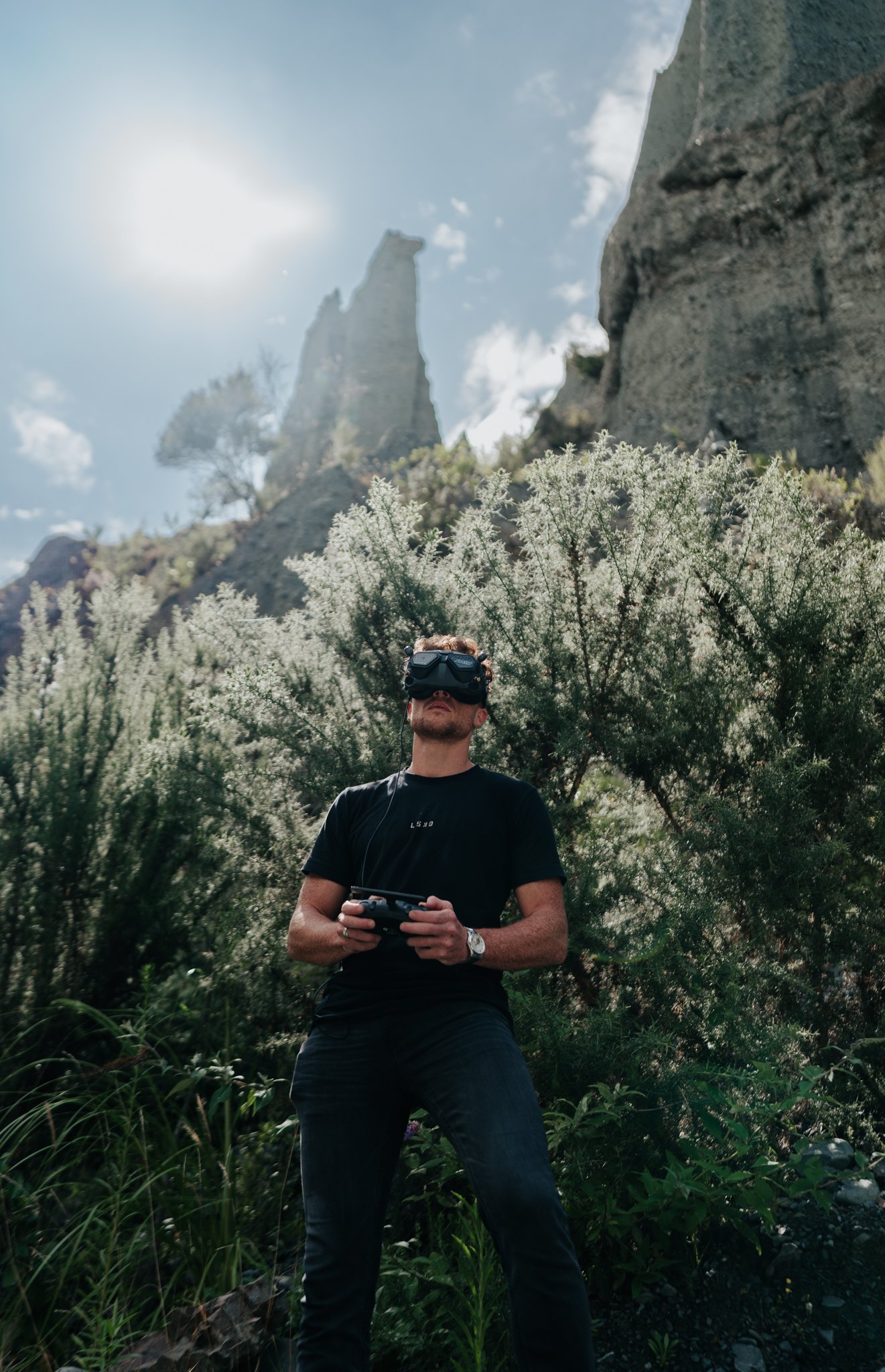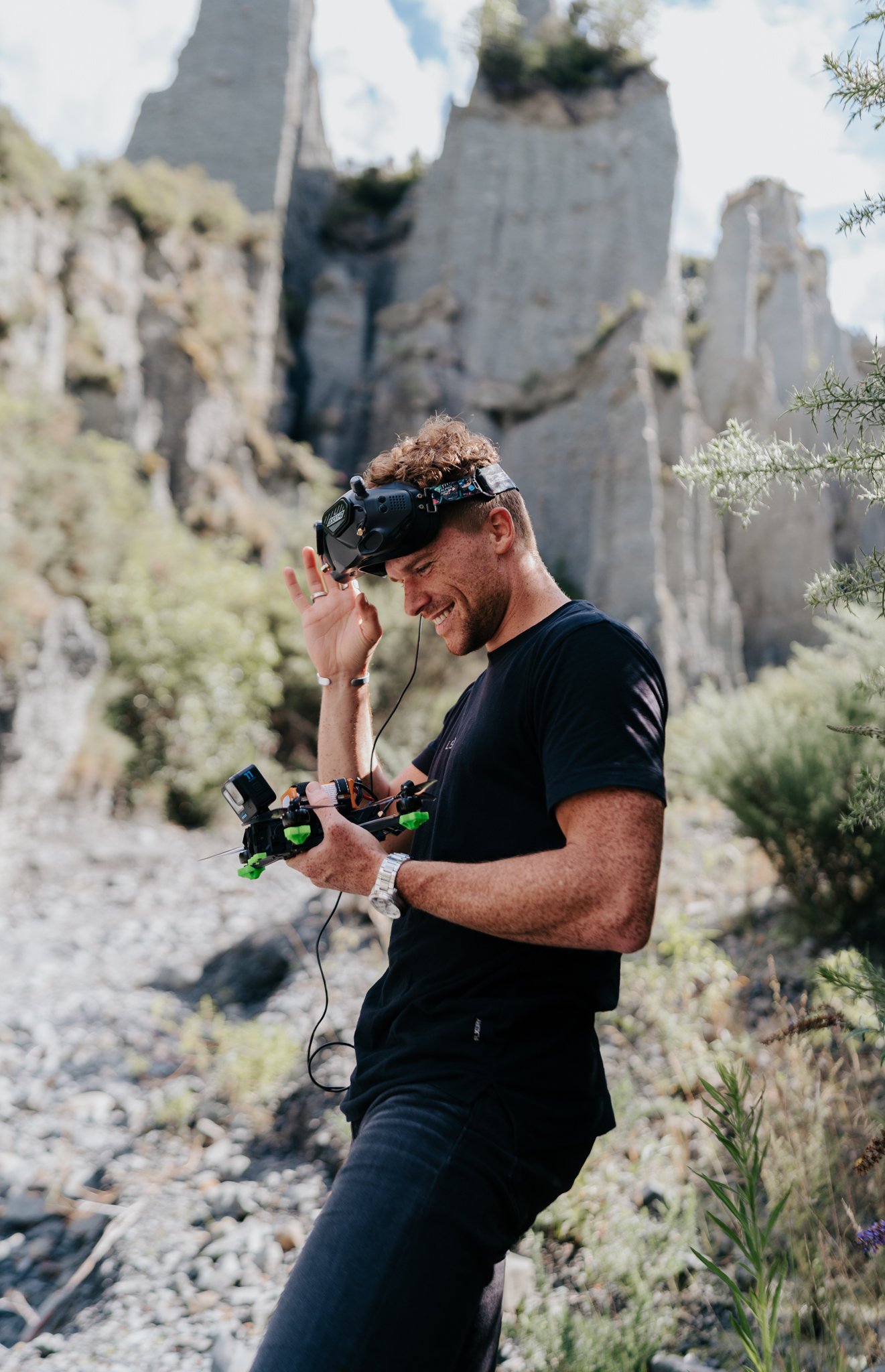A Beginner's Guide to FPV Drone Flying: From Simulator to Sky
by Karlie Place + Colin Ringas
FPV (First Person View) drone flying is an exhilarating hobby that lets you experience the world from a bird's-eye view. However, diving straight into the world of FPV drones without prior experience can be overwhelming and expensive. To help you get started on your FPV journey, we've put together a step-by-step guide, starting with the most crucial first step: using a simulator.
Start in a Simulator
Before you invest in a real FPV drone, it's wise to familiarize yourself with the basics in a simulator. There are several excellent simulators available, but a few standout options include Liftoff, Velocidrone (which my boyfriend Colin started with in 2018), Uncrashed, and the DRL Simulator. Liftoff, in particular, is available on Steam and offers a great platform to practice with a gaming controller.
Why Simulator Training Matters:
Cost-Effective Learning: Simulators are a cost-effective way to hone your piloting skills without risking any expensive equipment.
Risk-Free Environment: Crashes in the simulator won't break your bank or your drone.
Controller Familiarity: Using a gaming controller in the simulator will prepare you for handling a real remote control.
Assess Your Interest: Simulators let you gauge your interest in FPV before making significant investments in hardware.
Transition to a Tiny Whoop
Once you've spent some quality time in the simulator and feel comfortable with the controls, it's time to take your first step into the real world of FPV. Consider getting a "Tiny Whoop" from a reputable brand like @newbeedrone. These small, indoor-friendly drones are a great way to practice flying around your house and begin to experience the thrill of FPV flight.
Benefits of Starting with a Tiny Whoop:
Indoor Friendly: Tiny Whoops are safe to fly indoors and won't cause any harm to people or property.
Build Confidence: Flying a Tiny Whoop helps build confidence and improves your control skills.
Low Maintenance: They're generally low-cost and easy to maintain, making them a budget-friendly choice for beginners.
Graduating to a 5-Inch Freestyle Quad
After gaining confidence with your Tiny Whoop, you might be eager to experience the full power and agility of a 5-inch freestyle quad. However, these quads are faster and more powerful, requiring greater skill and responsibility.
Considerations Before Upgrading:
Investment: 5-inch quads can be costly, so ensure you're fully committed to the hobby.
Safety: Learn about the rules and regulations in your area for flying drones.
Maintenance: Be prepared for more complex maintenance and repair tasks.
Consider Learning with Others
The journey into FPV drone flying can be more enjoyable and educational when shared with others. The author mentions discussions about creating a series to help beginners learn alongside a friend or partner. Learning together can be motivating, and you can troubleshoot issues and share experiences.
Benefits of Learning with Others:
Motivation: It's easier to stay motivated when you have a partner to learn and progress with.
Collaborative Learning: Two heads are better than one when it comes to solving problems and sharing tips.
Safety: Having a buddy around can provide an extra layer of safety, especially when flying outdoors. It’s actually legally required to have someone as your eyes with line of sight when flying FPV
Q&A with Colin Ringas
In addition to the exhilarating feeling of being in control of your FPV drone's movements, there are a few more aspects of this hobby worth exploring. It's essential to address some common questions that beginners might have, such as:
Q. Why do you mount a GoPro instead of using the attached camera?
A. Great question! When it comes to capturing stunning FPV footage, using a GoPro is often preferred over the built-in cameras of many FPV drones. In my case, I have the older DJI Air Units (FOV system) in my quads, which would record footage at 1080p. However, by mounting a GoPro 11, I can capture 5K footage with superior colors, low-light performance, and phenomenal stabilization, thanks to software like ReelSteady. This level of quality allows for breathtaking FPV videos that stand out.
Q. What goggles do you use?
A. I use the DJI FPV Goggles V2, not to be confused with the DJI FPV Goggles 2. Additionally, I've equipped them with a Flight head strap for added comfort and stability during flights.
Q. What kind of drone is this, and what would you recommend for FPV real estate videos? I want to step up my game.
A. The drone I've been using on this journey is a Nazgul5, which is a fantastic option for FPV enthusiasts. However, when it comes to FPV real estate videos or capturing cinematic shots indoors, I opt for a @geprc cinelog25 paired with a stripped-down GoPro 11. This combination provides the versatility and image quality needed for professional-grade FPV real estate videography. To step up your game in this niche, investing in a drone setup like this can be a game-changer.
Q. How did you export? My video never looks this sharp.
A. I don't know the specifics off the top of my head, but I usually export my FPV footage in 4K at 30fps and then downscale it to 1080p at 30fps. I've found that this format tends to work best for Instagram uploads, ensuring sharp and crisp visuals.
Q. Do you shoot with D-Cinelike?
A. Surprisingly, no. While I used to shoot in D-Cinelike with my Mavic and other drones, my FPV footage is often shot in regular mode. This choice is influenced by my frequent travels and the need to turn content around quickly, often on the same day or the day after. Since most of my content is for social media or even just for stories, I find that shooting in regular mode and doing minimal grading suffices. There's no need to go overboard with color grading and post-processing.
Q. Where do I buy an FPV drone? Any suggestions?
A. You can find FPV drones at various retailers. For a great selection of gear, check out @get_fpv online. If you're interested in the DJI Avata or a DJI FPV drone, @djiglobal is a reliable source. Additionally, brands like @iflightgo and @geprc offer excellent prebuilt FPV drones, which you can purchase directly from them or through @get_fpv's website.
Q. How much is the setup on one of those FPV drones?
A. Estimating from memory, here's a rough breakdown of the costs for an FPV drone setup:
Drone itself: approximately $650
Controller: around $200
Goggles: roughly $750
GoPro: approximately $400
Drone battery: about $40
Please keep in mind that these prices can vary depending on the specific components and brands you choose.
Q. Do you like to fly more around a 20 or 30-degree camera angle?
A. Adjusting the camera angle on my FPV drone is somewhat second nature to me now. I typically change the camera angle depending on the location and the type of flying I'll be doing. For slow indoor flights or precise maneuvers, I might keep the camera angle at 0 degrees. However, for faster, more dynamic flights, I adjust it accordingly. It's become instinctive for me to tweak the camera angle to match the speed and style of my flying. I apologize if that doesn't provide a specific angle; it's all about adapting to the situation and personal preference in the moment.
Q. Which was your first drone camera?
A. My journey into drone flying started with one of the early @djiglobal Phantoms. I've been flying their drones for years, and they've always provided a reliable and user-friendly experience. Currently, I frequently fly the Mini 3 Pro for various purposes. However, when it comes to FPV drones like the one featured in this blog post, I began building my first quads back in 2018 and 2019, which marked the beginning of my adventure in the world of FPV.
Q. What do I need to know about a drone License?
Before embarking on your FPV drone flying journey, it's essential to emphasize the importance of adhering to local regulations and obtaining the necessary licenses and permits. In the United States, for instance, the Federal Aviation Administration (FAA) requires drone operators to follow specific guidelines, especially if you intend to use your FPV drone for commercial purposes or in controlled airspace. To fly legally and responsibly, we strongly recommend becoming a licensed drone pilot with the FAA by obtaining a Part 107 Remote Pilot Certificate. This certification involves passing an exam that covers various aspects of drone operation, safety, and airspace regulations. Even if you don't plan on using your FPV drone commercially, understanding these regulations is crucial for ensuring the safety of yourself, others, and the airspace. Ignoring or neglecting these rules can result in serious consequences, including fines and legal issues. So, before you take off with your FPV drone, take the time to educate yourself about the specific regulations in your region and obtain any required licenses or permits. Safety and compliance should always be at the forefront of your FPV flying experience.
Conclusion
Starting your journey into FPV drone flying with a simulator and gradually progressing through different stages of equipment is a smart and enjoyable approach. Whether you're a solo enthusiast or considering learning with a friend, the FPV community is welcoming and eager to help newcomers. So, take the first step, and soon you'll be soaring through the skies with your FPV drone, experiencing the world in a whole new way.
Disclaimer:
We strongly advise against flying any drone, including FPV drones, without the appropriate licenses and permits required by local authorities, such as the FAA Part 107 in the United States. Flying without the necessary licenses and adhering to regulations can lead to legal repercussions and safety risks. Always prioritize responsible and lawful drone operations.
Colin’s Featured FPV Work









